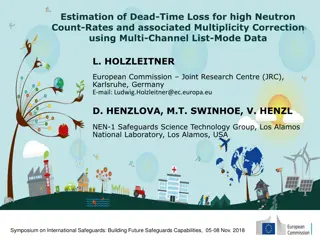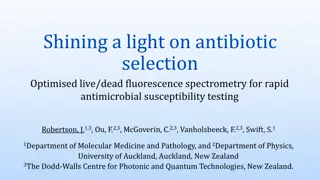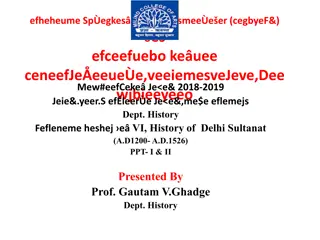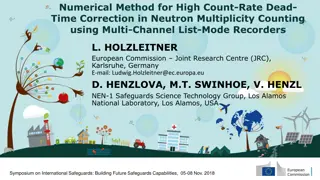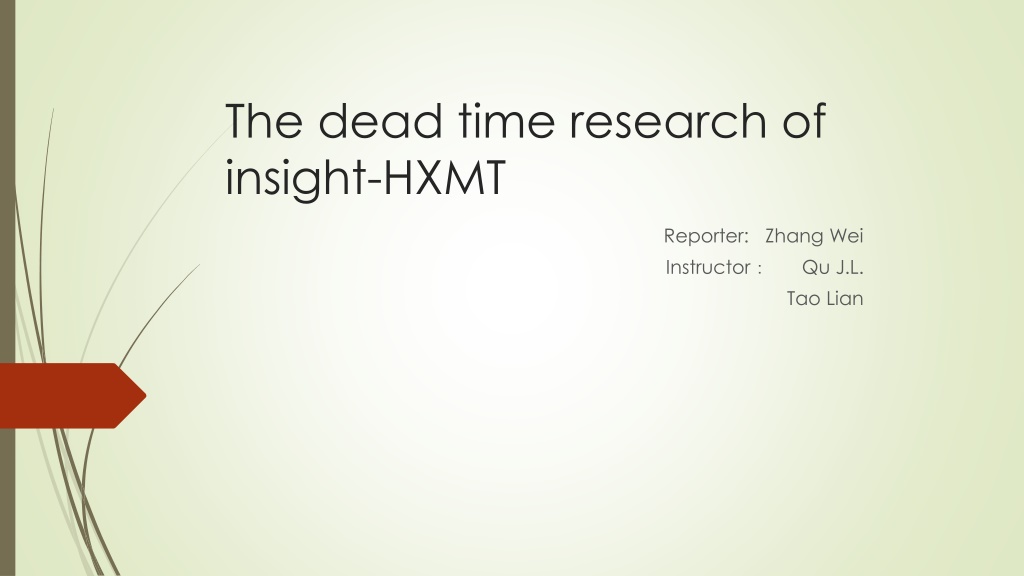
Understanding Dead Time Research in HXMT - Insight by Zhang Wei
Explore the concept of dead time in HXMT research, its impact on detector performance, and models for correction. Discover how dead time affects X-ray sources and the detectors in HXMT, including HE, ME, and LE. Dive deep into the unique characteristics of each detector module for a comprehensive insight into dead time research.
Download Presentation

Please find below an Image/Link to download the presentation.
The content on the website is provided AS IS for your information and personal use only. It may not be sold, licensed, or shared on other websites without obtaining consent from the author. Download presentation by click this link. If you encounter any issues during the download, it is possible that the publisher has removed the file from their server.
E N D
Presentation Transcript
The dead time research of insight-HXMT Reporter: Zhang Wei Instructor Qu J.L. Tao Lian
Definition of dead time The detector detects a photon and will not record other photons reaching the detector for a while. Dead time is dependent on counts rate The dead time can be expressed as: ? C = (1 DTF) C is the incident event. C is the detected event. DTF is dead time in 1 second. DT is dead time caused by an event. DTF=C * DT
HXMT dead time s performance dead time models Model fitting and correcting The factors affecting the ME s dead time
HXMT dead time s performance For x-ray sources, dead time makes the power spectrum out of Poisson noise distribution and deviate from 2. Dead time reduces the counts rate of the light curve Dead time increases the exposure time of the spectrum HXMT has three detectors include high energy detector(HE, 20-250keV) medium energy detector(ME, 5-30keV) low energy detector(LE, 1- 15keV)
HE detector The high energy detector consists of 3 sets of 18 composite crystal detectors.
For the high frequency, the PDS is normalized to 2. And no obvious dead time effect is founded. The HE s dead time is about two to three times the time precision. Maxi1535-571 ELV>10; COR>10; 0-5detector
For the low frequency, Different channels cause different results Because of the charged particle, the power raised up in low energy Cyg x-1 0-5 detectors, channel >= 50 Cygx-1 0-5 detectors, channel <= 50
LE detector The LE detector has 3 box, each box contains 8 detector modules. Adopt Swept Charge Device(SCD) SCD contains 100 detector units, and each piece transfers photon for about 10us. Whole SCD readout time is 1ms. Without dead time.
no dead time in LE detector The time resolution of a SCD is 1ms Maxi1535-571 ELV>10; COR>10;
ME detector The medium energy detector consists of 9 groups of 54 ASIC chips. Each group has 6 ASIC share a set of FPGA, forming a set of electronics.
ME dead time composed of AD transformation time and readout time. The 32 channel conversion will need about 162.125us, and read the signal, each signal needs 93.6875us. A total of N ASIC triggered signal dead time is: 162.125 + 93.6875 ? us
On the PDS, the dead time of the ME detector is quite obvious. And it dependents on count rate.
HXMT dead time s performance dead time models Model fitting and correcting The factors affecting the ME s dead time
dead time models According to the distribution of dead time, W. Zhang (1995) established models to correct the detector's dead time, and divided into two kinds: Paralyzable type ?0= ???? ????? Nonparalyzable type ??? ?0= 1 + ?????
Paralazble type Deadtime td ,time bin size tb tb td tb td td=10us,tb=10us td=10us,tb=1us
nonparalazble type td=10us,tb=1us
HXMT dead time s performance dead time models Model fitting and correcting The factors affecting the ME s dead time
Model fitting and correcting Using W. Zhang s models to fit the HXMT ME detector s PDS paralyzable type td 232.1 9.1 236.3 9.6 242.8 18.3 239.7 7.9 231.2 9.7 232.3 8.7 231.7 8.7 236.5 7.2 238.3 5.6 239.7 5.2 238.5 5.6 238.0 5.8 236.6 7.6 nonparalyzable type td 238.0 7.5 241.2 8.1 246.2 16.1 244.0 6.6 237.3 8.1 238.2 7.3 237.5 7.2 241.7 5.9 246.5 4.3 247.0 4.3 247.4 4.6 246.9 4.8 243.3 6.2 Source r0 R-s R-s 70.940 74.779 65.919 76.053 80.055 85.772 84.966 89.072 266.970 227.307 293.712 293.616 0.9379 0.9361 0.8439 0.9540 0.9281 0.9423 0.9408 0.9610 0.9750 0.9786 0.9753 0.9742 0.9456 0.9418 0.9513 0.8479 0.9571 0.9319 0.9459 0.9447 0.9644 0.9807 0.9806 0.9782 0.9771 0.9501 MAXI1535-571 Swift J0243+6124 Sco X-1 average
ME dead time correcting in PDS r0=76.053 dead time td 244us
HXMT dead time s performance dead time models Model fitting and correcting The factors affecting the ME s dead time
The factors affecting the ME s dead time The influence of different source, energy and counts rate on the dead time effect of ME detector. Three different bands. (5-10kev 10-15kev 15-30kev) Three different sources.
Dead time effect Using constant to fit the horizontal part of PDS calculate the difference between the horizontal and the Poisson distribution 2
According to PDS of three different sources and bands, we fit the model and calculate the dead time effect: 5-10keV 10-15keV R0 12.235 12.149 10.520 13.860 19.845 20.729 21.555 22.620 64.799 54.821 75.795 76.989 15-30keV R0 18.646 19.539 16.140 20.680 28.145 28.879 30.636 32.095 29.706 25.989 38.683 38.333 Source R0 effect 0.0194 0.0208 0.0184 0.0203 0.0278 0.0314 0.0286 0.0295 0.1457 0.1252 0.1516 0.1517 effect 0.0105 0.0102 0.0093 0.0118 0.0156 0.0176 0.0186 0.0199 0.0555 0.0475 0.0654 0.0661 effect 0.0155 0.0169 0.0143 0.0174 0.0246 0.0248 0.0267 0.0274 0.0269 0.0218 0.0330 0.0323 22.573 23.539 21.228 24.169 32.355 36.519 33.167 34.765 173.893 147.678 180.940 181.026 MAXI J1535-571 Swift J0243+6124 Sco X-1
Correlated with the counts rate Independent of the energy
conclusion ME is familiar with nonparalyzable type model Nonparalyzable fitted dead time is 243.33us ME dead time effect on the PDS is correlated with counts rate and independent of the energy


![READ⚡[PDF]✔ Yup I'm Dead...Now What? The Deluxe Edition: A Guide to My Life Info](/thumb/20463/read-pdf-yup-i-m-dead-now-what-the-deluxe-edition-a-guide-to-my-life-info.jpg)








